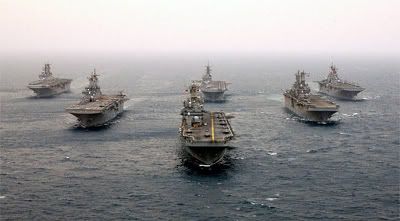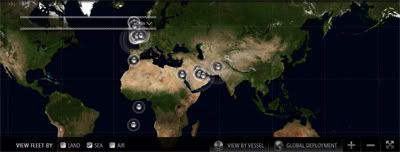
photo credit US Navy/Mate 2nd Class Larry S. Carlson
If there's one thing I love, it's a man in a sailor suit. But if there's one thing I hate, it's people who waste my time and my money while they (mostly) hang out (as in are not in combat). And on a boat, nonetheless! (Well, there I may just be jealous...) So what are my feelings when it comes to the Navy? Mixed - at best. But a colleague of mine recently approached me with a pretty cool idea.
Let's have a look at our Navies first. For the purposes of this article, I've chosen to look at the United States Navy and the Royal Navy of the United Kingdom. The US Navy is the largest in the world with 323,700 men and women and a fleet that is greater than the next four largest navies combined. (source) The Royal Navy is a bit smaller with 36,600 men and women and is in the top 25 largest fleets in the world, sixth-largest in the NATO Alliance (the United States being first). (source) (source) Consider the energy and money needed to run fleets that large. Or at least try to, because honestly no one even knows these amounts for sure.
"As the saying goes, facts are many but the truth is one. The truth is that the U.S. military is the single largest consumer of energy in the world...The reality is that even U.S. Department of Defense (DoD) does not know precisely where and how much energy it consumes." (source)
It does go on to state, however, that we do know "The U.S. Navy is the largest diesel fuel user in the world" (as of 2005). In fact, they were even presented with an award for "energy security" that says so.
The Royal Navy has its own concerns:
"According to various sources, including the Ministry of Defence, the UK has the third- or fourth-highest military expenditure in the world, despite only having the 25th largest military in terms of manpower." (source)
And I'm sure we've all heard about the aircraft situation.
But let's get right down to it. How much money is being spent? The annual United States military budget as of 2006 was the largest of any NATO country at $667.7 billion. The Royal Navy came in second at $59.638 billion (or roughly £36.986 billion). We can assume approximately 1/3 of that total is going to the navies of each country, so let's say $222.6 billion for the US Navy and $19.879 billion (or £12.329 billion) for the Royal Navy. Safe to say that's probably more money than you or I could imagine. (source)
So what are they doing with it? Let's have a look at their mission statements:
United States Navy
"The mission of the Navy is to maintain, train and equip combat-ready Naval forces capable of winning wars, deterring aggression and maintaining freedom of the seas."
Royal Navy of the United Kingdom
"Our mission is to:
Defend: UK citizens, territory and trade worldwide.
Deter: Threats to UK peace and prosperity.
Defeat: Hostile acts against the nation."
Well and good, but keep in mind the wars we're actually fighting here - and the people we're fighting against. The US and the UK have been best buddies for a while now, so for the most part it can be assumed that wherever one is, you'll likely find the other close by (minus home ports). The Royal Navy provides this map on their website offering general location of their fleets:

image credit Royal Navy of the United Kingdom, click for larger
Have a look at some of those dots. Proportionally more are close to home ports, not even in areas of conflict, and the ones that are have been fighting "asymmetrical" wars - meaning the sides are not weighed evenly. The US/UK navies are huge, and the terrorist/pirate/insurgent forces aren't much of a match.
Said Secretary of Defense Robert Gates in 2009, "What all these potential adversaries—from terrorist cells to rogue nations to rising powers—have in common is that they have learned that it is unwise to confront the United States directly on conventional military terms." (source)
More often than not, the navies spend their time on patrolling or training exercises, which have their own problems.
So how could we be spending that money a bit better?
Well, I'm sure we all know by now that fish stocks are declining at an alarming rate due to overfishing, marine development, pollution and disruptions in the balance of ecosystems. Perhaps some of our navy boys could do a bit more to protect the seas they live and work on - from an environmental standpoint. If we take a glance back at some of the other tasks the navies are responsible for, we can clearly see listed on the UK site:
"Some of our tasks:
-Helping to police the world’s oceans to prevent international smuggling, illegal trade, terrorism and pollution
-Monitoring the weather and ocean conditions and surveying coastlines and ocean beds"
And:
"Offshore patrol vessels play an important role in UK home waters by enforcing fishery laws and providing a reassuring presence in UK oil and gas fields."
...US, would you like to step up?
So it seems part of the navy's job (the UK at least, although I feel pretty confident the US has similar responsibilities) already includes policing the seas a bit. That's great - because as fish and other marine populations decline, the need for protected marine areas is increasing. These are areas of water important to marine species where human use is limited or completely restricted. It can include regulations on fishing gear, species caught, seasonal use, shipping traffic or any other human activity that might disrupt marine life.
"In the U.S., MPAs span a range of habitats including the open ocean, coastal areas, inter-tidal zones, estuaries, and the Great Lakes. They also vary widely in purpose, legal authorities, agencies, management approaches, level of protection, and restrictions on human uses." (source)
Click here to see US MPAs
"In the UK, MPAs are set up primarily for the conservation of our marine biodiversity and to protect species and habitats of international or national importance. The main types of MPA in the UK are Special Areas of Conservation (SAC). SACs, in addition to Marine Nature Reserves (MNRs) and Special Protected Areas (SPAs) are protected by statutory obligations. The UK also has voluntary MPAs such as Voluntary Marine Conservation Areas (VMCAs) and Voluntary Marine Nature Reserves (VMNRs)." (source)
Click here to see UK MPAs
Recent research suggests that we need to establish MPA networks across 20 - 30% of our oceans. (source). Although there has recently been increased attention to Marine Protected Areas (MPAs), currently only 0.7% of the ocean is protected. (source)
Clearly, we need to establish more. So where should we focus our efforts?
Well, for starters we need to cover a little bit of everything.
"Networks must be representative in terms of different ecosystems, habitats and communities and may have different uses and levels of protection within them, but all should include reserves or no take zones (NTZs)...NTZs may be in isolation, surrounded by normal fishing grounds, or form part of a larger marine reserve, managed for nature conservation, with managed buffer zones around the NTZ." (source)
The Convention on Biological Diversity (CBD) and the International Union for Conservation of Nature (IUCN) emphasize four factors in establishing an MPA: Adequacy to support the success of target species, representability for all of the location's biological processes, resilience in the face of a natural disaster, and connectivity to other MPAs or areas of conservation. This last piece I think is the most important. We hear a lot about "islands" in modern conservation research. Not actual islands, but figurative islands - areas set aside for protection, but with no surrounding ways in or out for animal populations to move and migrate. Connectivity is especially important in a marine environment where there are little to no boundaries and many species will move across entire oceans.
MPAs are beneficial to fish and other harvested or endangered marine species in that they afford a safe place for populations to reproduce, grow, feed and thrive without interference from humans. A big current issue is the overfishing and illegal fishing of species throughout our world's oceans. An increase in the percent coverage of MPAs throughout our oceans would help to deter that. The issue is that protecting large areas at sea has historically been a challenge. Now if only we could get some nice sea-faring people to watch over them for us...
What I'm suggesting is that perhaps we could re-work the non-combat navies to help police and patrol MPAs in their areas. It wouldn't take much to factor this in to existing patrol plans, and it would likely be an easy training exercise new recruits could easily master. And what if more navies participated than just the US and the UK? What if navies from every country helped police their protected areas and those neighbouring their own? More eyes on the water means greater enforcement against illegal and over fishing. And truly, at the end of the day, these navies would still be protecting their territories and their people. Food security is something we're going to be hearing more and more about soon. One-sixth of the world's population relies on fish and other seafood for their main source of protein, and if stocks continue to decline there's going to be a struggle. Not to mention the vast amount of biodiversity and the complex ecosystems we all rely on for a healthy sea. Perhaps we should make an international treaty and agree to protect our greatest resource together, with navies from every country that borders the sea - for our generation and the future's, for food systems and ecosystems, for dolphins, sharks, fish and people.
This article was done in collaboration with EcoHustler. Read his version here.
No comments:
Post a Comment